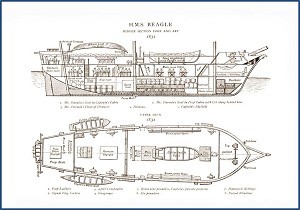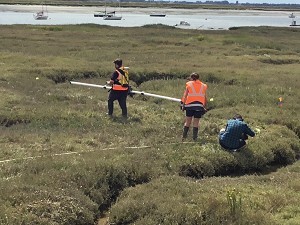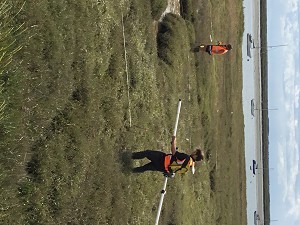The remains of the berth in Paglesham, Rochford, Essex where HMS Beagle was dismantled is now protected as a scheduled monument, Historic England announced on 11th May 2020. The dock is one of only five known mud docks anywhere in England.
2020 marks the 200th anniversary of the launch of HMS Beagle.
The remains of a rare 19th century dock, built to accommodate HMS Beagle when it was serving as a Coastguard Watch Vessel in Essex, is now protected as a nationally important site. The submerged mud berth on the River Roach near Paglesham has been designated as a scheduled monument by the Department forDigital, Culture, Media and Sport on the advice of Historic England.

HMS Beagle was first launched in May 1820 from Woolwich Dockyard on the River Thames and is most famous for being the vessel on which Charles Darwin made the observations necessary to develop his theory of natural selection. Following three far-flung exploratory voyages the Beagle was refitted as a static watch vessel for the Essex Coastguard in 1845 serving to curb smuggling until it was sold for scrap in 1870.
In 2019 Historic England commissioned Wessex Archaeology to investigate the Paglesham mudflats in Rochford thought to be the last resting place of the Beagle, ahead of the bicentenary of the vessel’s launch in May 2020. Maritime archaeologists confirmed the location of the mud dock and a brick slope or ‘hard’ using geophysical surveys and an aerial survey by drone.

The Rochford mud dock - a specifically cut mooring place in which a vessel rests on the bottom at low tide - was constructed sometime after 1847. Its outline, location and size matches the indentation of the riverbank recorded on early Ordnance Survey maps. Despite what was probably once a common feature on England’s major waterways, particularly in the absence of designed dockyards, the locations of purpose built mud docks are not well known. Only five mud docks are recorded in England.[1]
A mud dock of the same type can be seen in John Constable’s 1815 painting ‘Boat-Building near Flatford Mill’ on display at the Victoria & Albert Museum, London. Mud berths included the need for shoring to stabilise the sides, and wooden stocks to support the ship. The sloped brick hard extended alongside the dock and ship’s side allowing people access down the foreshore to low water.
Documentary evidence tells us the Beagle was in the Rochford dock in 1870 when it was sold. It was likely dismantled here, and lots of the material would have been taken and repurposed elsewhere. Remains of theBeagle may survive within the dock, though no more archaeological work is currently planned. Previous surveysundertaken by a team led by the late Dr Robert Prescott from the University of St Andrews in 2003, and more recent work by the University of Southampton, showed that there are the remains of potentially substantial material in the dock – this could be parts of the dock itself, another vessel possibly associated with the local oyster fishery, or the Beagle.
Nigel Huddleston, Heritage Minister, said: "The voyages of HMS Beagle had a transformative impact on the world and they began here on our shores two hundred years ago. As 2020 marks a special anniversary in the Beagle's past, it is fitting that the significant site of its last days will be protected for the future."
Duncan Wilson, Historic England Chief Executive, said: “This is a fascinating example of a rare piece of maritime history, linked to one of the world’s most famous ships. We are glad to see this site in a quiet corner of Essex given national protection.”
Rochford District Council’s Portfolio Holder for Enterprise, Councillor Simon Wootton, said: “We are extremely proud that this prestigious vessel ended her days on our shores, and that the site will now be recognised as a scheduled monument. Although our plans for celebrating HMS Beagle are on hold due to the COVID 19 pandemic, as soon as we are able Rochford District Council will be recommencing our plans for the commemoration of 2020 as the 200th anniversary of the launch of this famous vessel.
Rochford District Council will be creating a lasting commemoration to the ship in the form of a new observation platform at the RSPB Wallasea Island Wild Coast Project, overlooking the River Roach where the ship was moored.
From this spot, thanks to the support of the National Lottery Heritage Fund, visitors will be able to immerse themselves in a Computer Generated Image (CGI) Tour of the HMS Beagle simply by holding their smartphones or tablets up to the horizon.”
History
HMS Beagle was launched in 1820 and participated in celebrations of the coronation of King George IV the following year, but is most famous for its three voyages of exploration to survey the coasts of Patagonia, Tierra del Fuego and Australia.
In August 1831, aged 22, Charles Darwin was offered the opportunity by his botany professor to join the HMS Beagle on a voyage around the world to create sea-charts. The offer had been made to two others before Darwin, but they had turned it down.
The young Captain FitzRoy was looking for a scientific-minded gentleman who would also be a companion. The voyage would be an excellent opportunity to collect, observe, and write about flora, fauna and geology in South America and beyond.
HMS Beagle set sail from Plymouth in December 1831. The voyage was to last for two years but lasted almost five. The Beagle returned to Plymouth in October 1836. Darwin’s diary was later published as ‘The Voyage of theBeagle’ in 1839. Darwin became the most influential scientist, writer and thinker on evolution in part thanks to his time on the Beagle.
Although the voyage had been commissioned by the admiralty, Captain FitzRoy had insisted on many alterations to the ship, including adding a third mast to make it more stable at sea and creating space for the many surveying instruments on board.
In 1845, the Beagle transferred to the Customs Service to control smuggling on the Essex Coast as a static coastguard watch vessel. Its masts were removed and it was renamed CGWV No. 7. Moored mid-river in Paglesham Reach, the ship kept watch over part of the River Roach Tidal River System. Census records from the 19th century show that the ship accommodated seven coastguard officers and their families, who would have integrated with the local community.
In 1870, the ship was sold to be broken up in the dock. The lower portion of the vessel (comprising the keel, futtocks and inner planking) would have been difficult to remove from the mud and therefore potentially survives. It is believed that the upper timbers above the waterline were repurposed and used in local building construction.
HMS Beagle Timeline
1820: HMS Beagle was launched as a 10-gun Cherokee-class brig-sloop on 11 May 1820
1821: The Beagle participates in celebrations of the coronation of King George IV
1826-30: Voyage of exploration to survey the coasts of Patagonia and Tierra del Fuego
1831-36: Charles Darwin joins the voyage of exploration on the Beagle to survey the coast of Tierra del Fuego
1837-43: Voyage of exploration to survey the coast of Australia
1845: The Beagle is transferred to the Customs Service to control smuggling on the Essex Coast. It is refitted as a static coastguard watch vessel – its masts are removed and it is renamed CGWV No. 7
1851: Purpose-built mud dock constructed as the Customs Service is asked to remove the ship as it is obstructing the river and its coastal oyster-beds, home to the cultivation and harvesting of the European flat oyster
1870: The ship was sold to be broken up in the dock
2003: The British led spacecraft Beagle 2, named in honour of HMS Beagle, landed on Mars
About Historic England
We are Historic England, the public body that helps people care for, enjoy and celebrate England’s spectacular historic environment, from beaches and battlefields to parks and pie shops. We protect, champion and save the places that define who we are where we’ve come from as a nation. We care passionately about the stories they tell, the ideas they represent and the people who live, work and play among them. Working with communities and specialists we share our passion, knowledge and skills to inspire interest, care and conservation, so everyone can keep enjoying and looking after the history that surrounds us all.
Listing
The National Heritage List for England is held and managed by Historic England on behalf of the Government and Secretary of State for Digital, Culture, Media and Sport. It identifies the buildings, sites and landscapes which receive special protection, so they can be enjoyed by current and future generations. There are over 400,000 items on the List, covering England's most valued historic places. You can now use the map on our website to find your nearest listed buildings using our new ‘near-me’ function. Follow this link and click on the ‘Use current location’ button to view your nearest list entries. For further information, see What is Listing?
Discover 2020
Follow Rochford District Council’s Discover 2020 social media channels for the latest vlogs about the hunt for the HMS Beagle. Just connect with us on the following channels, and please share your stories about our local connection to the HMS Beagle.
Facebook - discover2020
Twitter @Discover_2020
Instagram discover2020festival
About The National Lottery Heritage Fund
Using money raised by the National Lottery, we inspire, lead and resource the UK’s heritage to create positive and lasting change for people and communities, now and in the future. www.heritagefund.org.uk.
Follow @HeritageFundUK on Twitter, Facebook and Instagram and use #NationalLotteryHeritageFund


___________________
[1] A mud dock is recorded in Sheerness Dockyard, Kent. The walls of a mud dock in Bristol are listed at Grade II (https://historicengland.org.uk/listing/the-list/list-entry/1202622) – it is thought to be the oldest surviving 18th-century inlet dock. Mud docks are also known historically - the wrecks of the 15th-century naval ships Grace Dieu and Holigost lie in well-recorded mud docks in Hampshire on the River Hamble (https://historicengland.org.uk/listing/the-list/list-entry/1000061) and are both associated with the development of the medieval mud docks at Bursledon.
< Back to the news